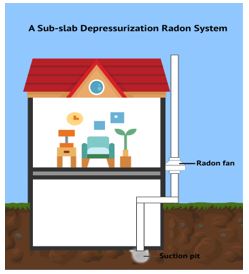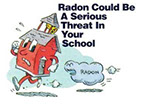
708-625-4488
How do Radon Mitigation Systems Differ?

Thankfully, lately, radon has been getting the attention it deserves, and it deserves a lot. Besides smoking, it is the leading cause of lung cancer in the United States. It is seemingly unavoidable because it is colorless, odorless, and virtually undetectable to the natural five senses. Radon is a naturally occurring element found prominently in counties throughout DuPage, Will, Kankakee, Grundy, Kendall, and Cook counties. So, to sum up: Radon is a potentially lethal gas that you cannot naturally observe, and you may have already been exposed to it. So yes, it is very fortunate it is receiving its due notoriety. Thankfully, at Precision Enviro Services, we have literally gotten the testing process for high radon levels down to a science. There are very few variables when it comes to performing a successful test. However, radon mitigation is a different story. The story may be different, but the ending remains the same. The expert radon mitigation professionals at Assure Mitigation Services know how to keep best the residents of any building safe from the dangers of radon poisoning. However, unlike our testing process, multiple ways to mitigate a home exist.
Some of the most common types of radon mitigation systems include:
Active Soil Depressurization (Exterior)
An active soil depressurization system is typically used in homes with a crawl space. A fan is installed in the crawl space, and a pipe is run from the fan to the outside of the house. The fan creates negative pressure in the crawl space, which pulls radon gas out of the soil and prevents it from entering the home.
Active Soil Depressurization (Interior)
This type of system is most effective for homes with a basement. A pipe is installed through the foundation and into the soil underneath the basement floor. The pipe is connected to a fan, which creates negative pressure and draws the radon gas out of the soil and away from the house.
Active Soil Depressurization (Slab)
This type of system is most effective for homes with a concrete slab foundation. A pipe is installed through the foundation and into the soil underneath the house. The pipe is connected to a fan, which creates negative pressure and draws the radon gas out of the soil and away from the house.
Crawlspace Sub-Membrane Depressurization (CSD)
This type of system is most effective for homes with a crawlspace. A plastic sheet is installed over the crawlspace floor, and a pipe is connected to the sheet. The pipe is connected to a fan, which creates negative pressure and draws the radon gas out of the soil and away from the house.
Sump Pit Radon Mitigation Systems
This type of system is most effective for homes with a sump pit. A pipe is installed from the sump pit to the outside of the house. The pipe is connected to a fan, which creates negative pressure and draws the radon gas out of the soil and away from the house.
No matter which type of system you choose, it’s important to have it installed by a qualified professional. Radon mitigation systems can be very effective at reducing radon levels in your home, but only if they’re installed properly.
Precision Environmental Services is licensed and certified in testing radon, mold, asbestos, and indoor air quality. Call us today at 708-625-4488.
Suffering from Allergies or Asthmatic Symptoms? Test your Indoor Air Quality
We tend to think of air pollution as a risk faced outside, but the air we breathe indoors can also be polluted. Smoke, vapors, mold, and chemicals used in certain paints, furnishings, and cleaners can all affect indoor air quality and our health.
Buildings affect overall well-being because most people spend most of their time inside. The U.S. Environmental Protection Agency estimates Americans are indoors 90% of their time – in built environments such as homes, schools, workplaces, places of worship, or gyms.
Environmental health researchers study how indoor air quality affects human health and well-being. Both short- and long-term exposure to indoor air pollution can cause a range of health issues, including respiratory diseases, heart disease, cognitive deficits, and cancer.
Types of Pollutants
Many factors contribute to poor indoor air quality. Indoor air includes pollutants that penetrate from the outdoors, as well as sources that are unique to the indoor environment. Some contaminants are described below:
• Allergens are substances that can trigger the immune system, causing an allergic reaction; they can circulate in air and remain on carpets and furniture for months.
• Asbestos is a fibrous material formerly used for making incombustible or fireproof building materials, such as roof shingles, siding, and insulation. Disturbing asbestos minerals or asbestos-containing materials can release fibers, often too small to see, into the air. Asbestos is known to be a human carcinogen.
• Carbon monoxide is an odorless and toxic gas. It is found in fumes produced any time you burn fuel in cars or trucks, small engines, stoves, lanterns, grills, fireplaces, gas ranges, or furnaces. Proper venting or exhaust systems prevent build up in the air.
• Formaldehyde is a strong-smelling chemical found in some pressed wood furniture, wood particle cabinets, flooring, carpets, and fabrics. It can also be a component of some glues, adhesives, paints, and coating products. Formaldehyde is known to be a human carcinogen.
• Mold is a microorganism and type of fungus that thrives in damp places; different molds are found everywhere, indoors, and outside.
• Radon is a colorless, odorless, naturally occurring gas that comes from the decay of radioactive elements in soils. It can enter indoor spaces through cracks or gaps in buildings. Most exposures occur inside homes, schools, and workplaces. EPA estimates radon is responsible for about 21,000 U.S. deaths from lung cancer annually.
• Smoke, a byproduct of combustion processes, such as from cigarettes, cookstoves, and wildfires, contains toxic chemicals like formaldehyde and lead.
Precision Environmental Services is licensed and certified in testing radon, mold, asbestos, and indoor air quality. Call us today at 708-625-4488.

Since children, teachers, and staff experience radon exposure in schools many hours per week, it is important to know your school (or daycare) radon levels. For over 25 years, the EPA and IEMA has recommended radon testing in schools. In fact in Illinois daycares are REQUIRED to test every 3 years and post the results for the parents. This recommendation came after the national school radon survey found 1 of 5 schools had one or more rooms with high radon concentrations. Since radon exposure causes lung cancer, parents and employees of our schools have a right to know the levels in our schools. Watch this video on a former school teacher in Duluth, MN whose cancer has already spread to her lymph nodes and brain.
Do you know your home or school's radon levels? What about in your own home where you and your family spend 8 or more hours each day? If not, call Precision Environmental Services today at 708-692-7877. We provide accurate and prompt radon testing 7 days a week
To learn more about radon visit https://epa.gov/radon.
Test, Fix and Save a Life!
Do you know the radon levels in your school or daycare?
Oct 2020

Visit Our Videos
Copyright 2021 - Precision Environmental Service. All Rights Reserved - Web Design TSG MEDIA



